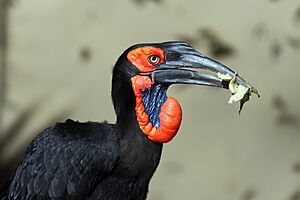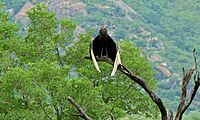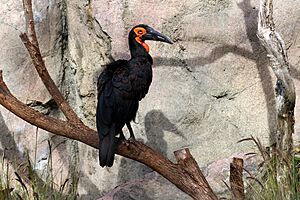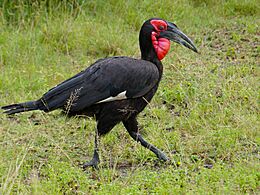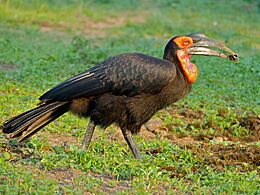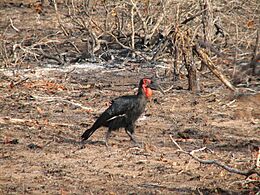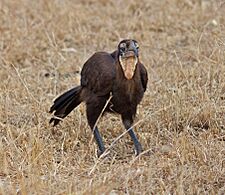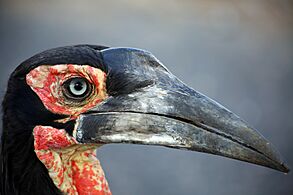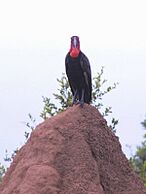Southern ground hornbill facts for kids
Quick facts for kids Southern ground hornbill |
|
|---|---|
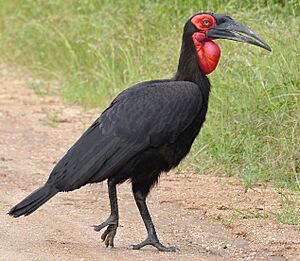 |
|
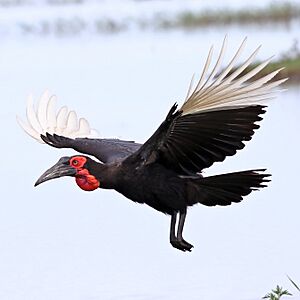 |
|
| Adult male, walking and in flight | |
| Conservation status | |
| Scientific classification | |
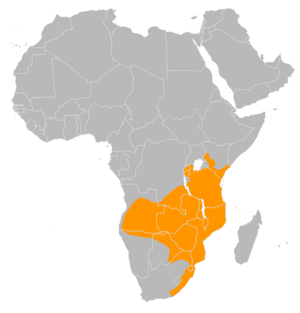 |
|
| Approximate range | |
| Synonyms | |
|
Bucorvus cafer (Vigors, 1825) |
The southern ground hornbill (Bucorvus leadbeateri) is a very large bird found only in Africa. It is one of two types of ground hornbills and the biggest hornbill species in the world. You can find these birds in southern Africa, from Kenya all the way to South Africa. They live in forests and grassy plains called savannas. The other type of ground hornbill is the Abyssinian ground hornbill.
Southern ground hornbills are meat-eaters. They hunt mostly on the ground, eating everything from insects to small animals. They often build their nests in tall tree holes or in rock holes on cliffs. These birds live a very long time, usually 50 to 60 years, and even up to 70 years if they live in zoos. Because they live so long, they don't start having babies until they are about 10 years old. You can tell males and females apart by their throat color: males have bright red throats, while females have deep violet-blue throats.
These birds are very important in the cultures of southern Africa. For example, Kruger National Park in South Africa calls them one of their 'Big Six' special birds. However, their numbers are going down. This is due to things like people harming them, their homes being destroyed, and certain cultural beliefs. The IUCN listed them as 'Vulnerable' in 2018. This means they are at risk of extinction. In countries like South Africa, Lesotho, Namibia, and Eswatini, they are even listed as 'Endangered', meaning they are in even greater danger.
Contents
Meet the Southern Ground Hornbill
The southern ground hornbill is a very big bird. It can be from 90 to 129 centimeters (about 3 to 4 feet) long. Female birds weigh between 2.2 and 4.6 kilograms (about 5 to 10 pounds). Males are larger, weighing from 3.5 to 6.2 kilograms (about 8 to 14 pounds). Their wings can spread out from 1.2 to 1.8 meters (about 4 to 6 feet) wide.
This hornbill is mostly black. It has bright red skin on its face and throat. Young birds have yellow skin there. This red skin might help keep dust out of their eyes when they look for food in dry weather. When they fly, you can see white tips on their wing feathers. This is a good way to spot them. Their beak is black and slightly curved. It has a bony growth on top called a casque, which is bigger on males. Female birds are smaller and have violet-blue skin on their throats. Young birds up to six years old have a dull gray patch instead of the bright red or blue throat.
Where They Live and What They Eat

Southern ground hornbills live across a wide area of Africa. You can find them from northern Namibia and Angola to northern South Africa and southern Zimbabwe. They also live in Burundi and Kenya. They need savanna areas with big trees for nesting. They also need short, thick grass for finding food.
These birds are considered a vulnerable species. This means they are mostly found in special nature reserves and national parks. They usually live in groups of 5 to 10 birds, including adults and young ones. Sometimes, different groups will chase each other in the air. Southern ground hornbills are top predators, which means they are very important for the health of their ecosystem. They hunt on the ground, eating reptiles, frogs, snails, insects, and even small mammals like hares. They rarely need to drink water. Their home range is limited in some areas because there aren't enough trees for them to build nests.
Southern ground hornbill groups are very noisy. They make loud calls together that can be heard up to 3 kilometers (about 2 miles) away. These calls help each group protect its territory. Their territory needs to be very large, sometimes as big as 100 square kilometers (about 39 square miles) in good habitats.
Life Cycle and Reproduction
Southern ground hornbills are cooperative breeders. This means that a breeding pair always gets help from at least two other birds. These helpers are usually younger birds from the group. Studies show that birds need at least six years of helping experience to be good parents themselves. This suggests that a pair cannot raise young successfully without help. The skills learned as a helper are very important for raising chicks as an adult.
In zoos, some southern ground hornbills have lived for up to 70 years. It is believed that birds that survive to leave the nest can live for 30 years or more in the wild. This is a very long lifespan for a bird, similar to birds like the wandering albatross.
Ground hornbills are thought to become adults at six to seven years old. However, very few of them start breeding at this age. Their nests are almost always deep hollows inside very old trees. Sometimes, they might nest on rock faces. They lay one to three eggs at the start of the wet season. But usually, only one chick survives because the older, stronger chick often harms its younger siblings. The eggs are pure white and have a rough texture.
After about 40 to 45 days of the egg being incubated, and then 85 days for the chick to grow feathers, the young bird is still dependent on its parents and helpers. It stays with them for one to two years, depending on the weather. This is longer than any other bird species. This means that ground hornbills can usually only have a successful brood every three years. Breeding every three years is very rare for birds.
Protecting the Southern Ground Hornbill
The southern ground hornbill is listed as vulnerable globally. This means it is at risk of extinction worldwide. However, in South Africa, where many studies have been done, it is listed as endangered. This means it faces an even higher risk of disappearing. It is also endangered in Lesotho, Namibia, and Swaziland. These birds in these countries, along with Kenya, Tanzania, Malawi, Zambia, Zimbabwe, and Mozambique, need special help to increase their numbers.
The main reason they are endangered is their slow breeding rate. Other big problems include losing their habitat, changes due to farming, cutting down trees, getting shocked by power lines, accidental poisoning, and people harming them.
People hunting or persecuting southern ground hornbills has been a complicated issue. Recent studies show they have been hunted more than thought, even in protected areas. Most of this hunting seems to happen by chance. Overall, hunting is probably not the main reason their numbers are dropping. But it is still something to consider, especially because they don't have many babies. Also, southern ground hornbills sometimes break windows because they see their reflection. Annoyed homeowners in cities have been known to kill birds that damage their property.
The role of southern ground hornbills in different cultural beliefs also affects how they are protected. Some beliefs actually help them. For example, the Ndebele believe it is wrong to kill southern ground hornbills. However, the birds are also used in traditional practices and medicines, which can be harmful. In some places, parts of the birds are used in traditional medicines. So far, research suggests that cultural uses do not have a big impact on their populations. For example, Ndebele healers use the bird for medicine, but they follow a very strict process that can take months or years. There are also plant alternatives for these cultural uses. While there has been some study on the traditional medicine trade, the trade of their meat (called bushmeat) is not well understood. It has only been seen in parts of Malawi.
This bird species is especially threatened by the loss of trees and their natural homes. They need huge areas for their territories. When large trees are cut down for farming or wood, or when their nesting areas are disturbed, it deeply affects the hornbills. Because human populations are growing, it's common to see a group's territory include both untouched natural areas and farms.
Southern ground hornbills lay one to three eggs, but only one chick is usually raised. Because of this, conservationists have started projects to raise the extra eggs in captivity. Projects like the Mabula Ground Hornbill Project hand-raise these extra chicks. Their goal is to release them back into the wild, but reintroducing this species has been difficult.
Southern Ground Hornbills in Culture
The southern ground hornbill's loud calls and large size have made it important in many traditional African cultures. It has inspired many cultural beliefs across the areas where it has lived for a long time. However, it's not clear if these beliefs will continue in the future, especially as Africa becomes more modern.
Linked to Death
In some cultures, the southern ground hornbill is connected to death and bad luck. Generally, some people see them as a sign, or even a bringer, of death, destruction, and loss. These beliefs are most common in South Africa, Zimbabwe, and Malawi. Some people in Burundi, Kenya, Tanzania, Zambia, and Mozambique see the bird as "unlucky and an aggressive bird associated with evil and death." Some in Tanzania also believe it holds angry spirits. Others in Zimbabwe think it can bring bad luck and should not be approached. This has led to different reactions to the hornbill, from avoiding it to even killing it.
For example, the Taveta people believe that killing a southern ground hornbill will cause a deadly illness for the killer. For the Ndebele people, killing them is forbidden and will bring death to the killer. The Ndebele also believe an older person will die if a southern ground hornbill comes near their home. The AmaXhosa people also have a rule against killing them, as they might be messengers of death sent by a witch-doctor.
Linked to Weather
The southern ground hornbill is well known for its connections to rain, drought, lightning, and general weather forecasts. Some people, like the Ndebele and those in coastal Tanzania, believe its early morning calls mean rain is coming. Cultures like the Xhosa believe the southern ground hornbill can be used to bring rain and end droughts.
This connection has led people to believe the hornbill can protect them from weather problems. It is thought that if the right traditional ritual is used, the bird can protect against lightning and drought. These rituals are different for each culture and need. They might involve using different parts of the bird, and also dancing and singing. This use has been seen in parts of South Africa and Mozambique.
Because they are linked to rain and drought, some cultures also use the southern ground hornbill to tell time. They can mark seasonal and daily changes, like the change from the wet to the dry season. There are small differences from country to country. In Malawi, some believe that seeing southern ground hornbills means it's time to prepare the fields. Some in Kenya and Tanzania use the bird to mark the dry season, which tells them when to move their cattle. In parts of South Africa, their calls are linked to the start of the rainy season. These beliefs usually don't harm the hornbills. However, there have been reports of people killing, moving, or using them to try and start or stop rainy seasons. Those who rely on the bird for weather predictions have blamed climate change for confusing their forecasts. They say it affects the hornbill's ability to call at the usual time.
Linked to Changing Perceptions
The southern ground hornbill is very good at spotting small creatures in tall grass. This might be why it has been linked to the ability to change how humans see things. Through traditional rituals, people believe the bird can help improve or change a person's ability to alter reality, create illusions, and expand their awareness. In Zimbabwe, Malawi, and South Africa, the bird can be used to try and improve a person's ability to find food, animals, and even enemies. Also, some believe the southern ground hornbill can be used to change how a person sees themselves. This has led to its use in rituals to give authority to leaders in certain cultures.
Other cultural uses or beliefs include getting rid of bad spirits, taking revenge on others, starting fights, making a person stronger, and making dreams come true.
Gallery
-
Catching beetles in dung



